Peter Stuyvesant’s NYC: From the Bouwerie Farm to That Famous Pear Tree
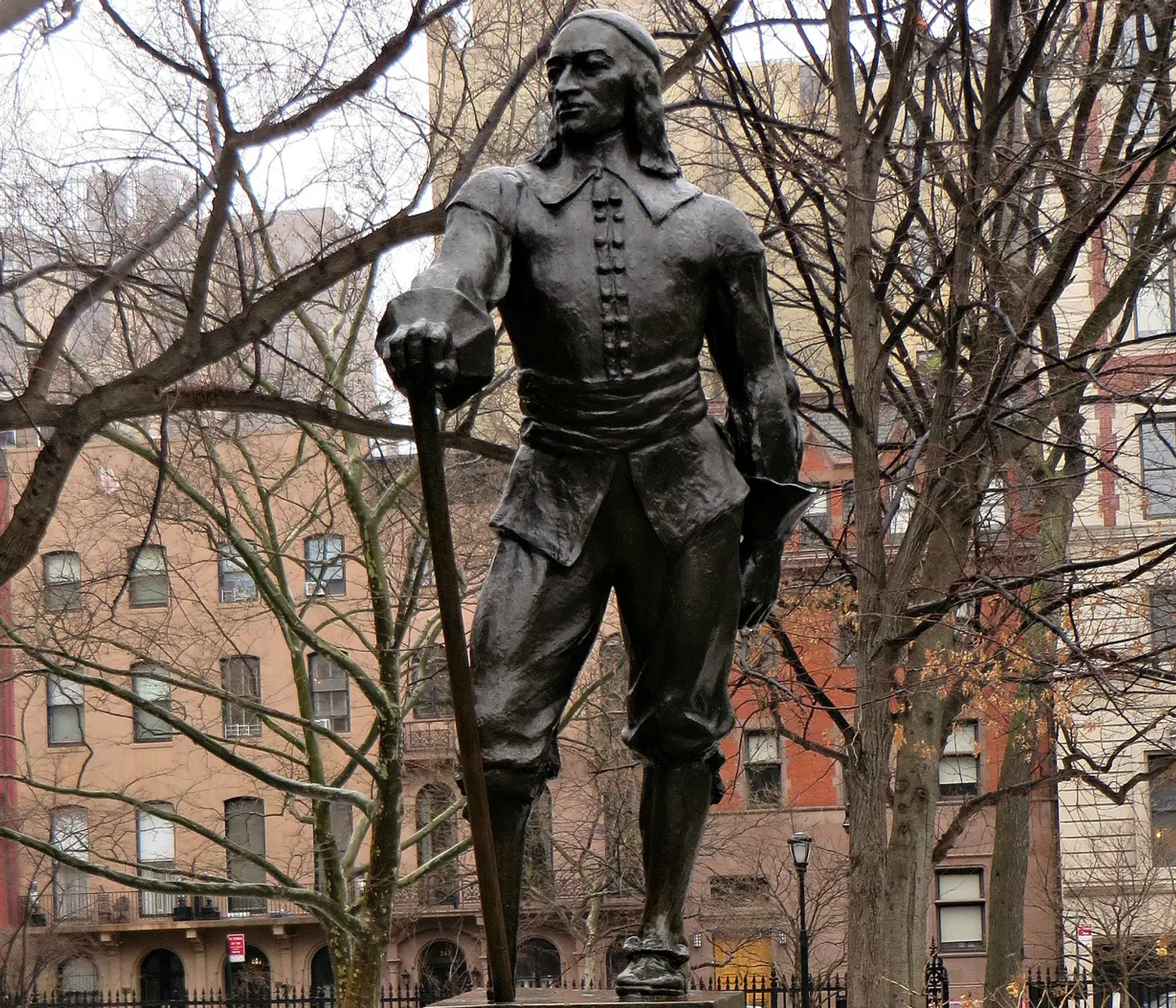
Monument to Peter Stuyvesant in Stuyvesant Square via edenpictures via photopin
A few quick facts from New York City history 101: The island of Manhattan was originally settled by the Dutch, and therefore officially named New Amsterdam in 1625. It was part of the larger settlement of New Netherland. Pieter, or Petrus, Stuyvesant (we know him today as Peter) was the last Dutch Director-General of the colony of New Netherland from 1647 until it was ceded to the English in 1664. His work greatly influenced the city’s expansion northward from the southern tip, and he was responsible for many major historic events, such as the erection of a protective wall on what is today Wall Street and the creation of a canal on today’s Broad Street and Broadway.
Now that it’s November–the month when the city celebrates its Dutch heritage through 5 Dutch Days–we decided to take a look at the old stomping ground of General Stuyvesant, as well as his lasting legacy in the city today.
Peter Stuyvesant’s Former Haunts
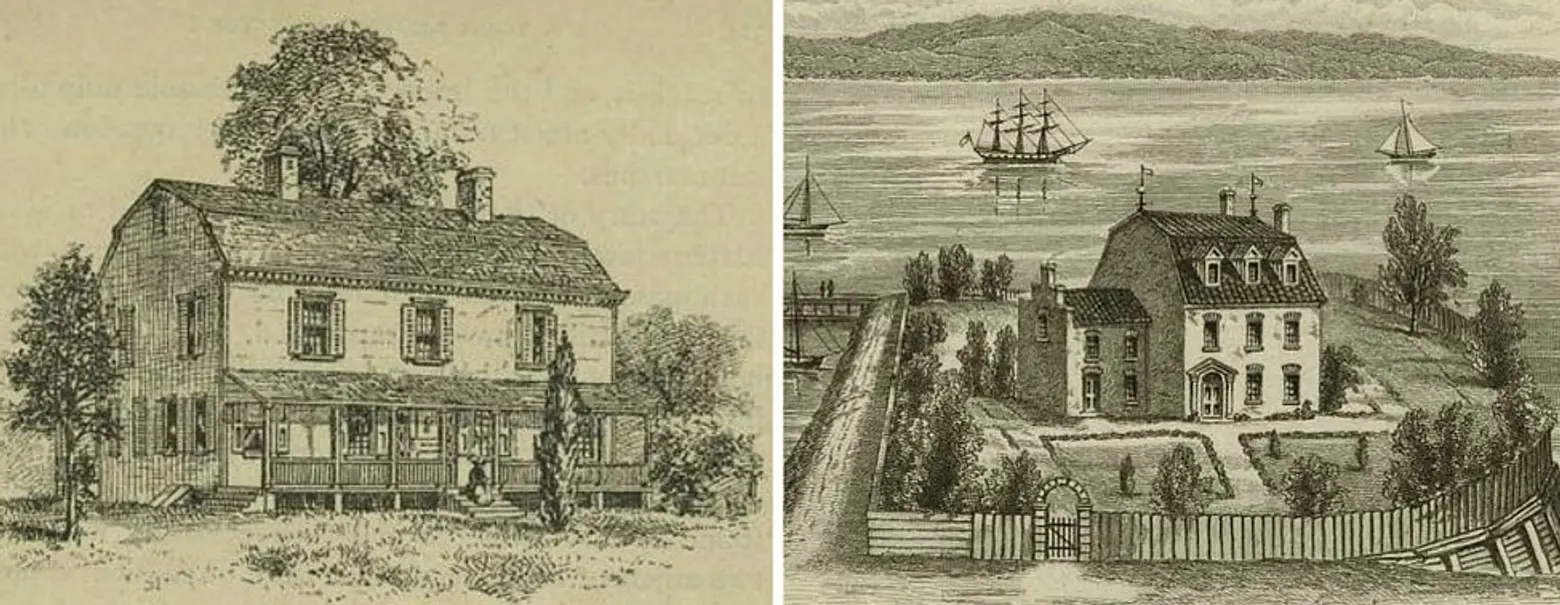 Stuyvesant’s Bouwerie House (L) and Whitehall (R), via NYPL
Stuyvesant’s Bouwerie House (L) and Whitehall (R), via NYPL
When the British took over in 1664 and renamed the colony New York City, they promised Stuyvesant land if he would surrender to the King. He did, and that same year he signed the deed to a house on his Bouwerie, or Bouwerij (the Dutch word for farm, which gave us the present-day name “Bowery”), a 62-acre tract of land covering today’s East Village and Stuyvesant Town (23rd Street to the north, Sixth Street to the south, Fourth Avenue to the west, and Avenue C to the east, to be exact), where he spent the rest of his life until his death in 1672. His house was located roughly at today’s First Avenue and 16th Street and had beautiful East River views, but it was destroyed by a fire in 1777.
Stuyvesant had also built another house, a stone governor’s mansion, farther downtown. When the British took over they named the building and the street Whitehall, after England’s seat of government. The mansion has long since been demolished, but the name lives on in the current Whitehall Street (not the same street as the original).
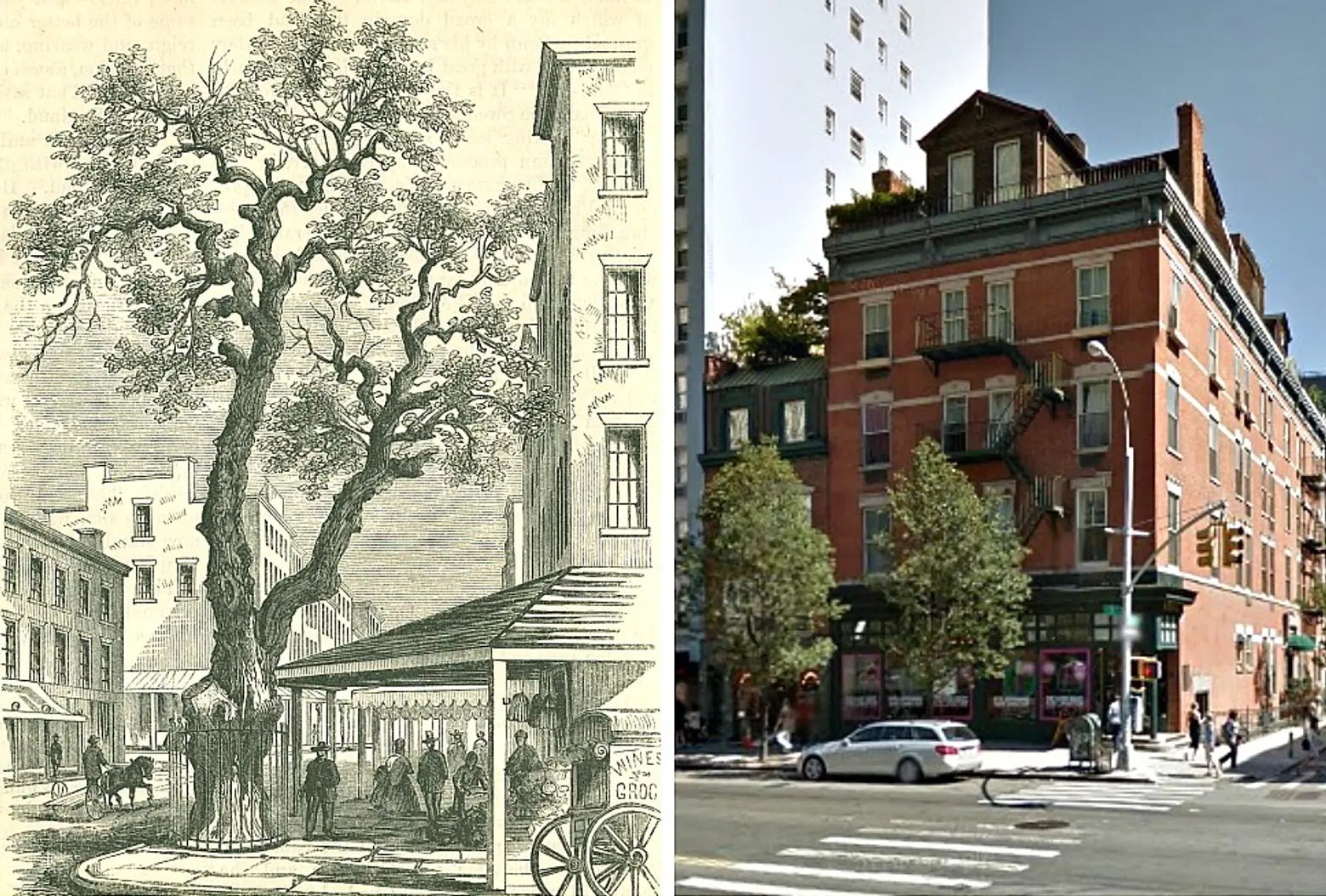 An historic image of the pear tree via Digital History Project (L); A current view of Kiehls and the new pear tree (R)
An historic image of the pear tree via Digital History Project (L); A current view of Kiehls and the new pear tree (R)
In 1647, Stuyvesant returned from a trip to the Netherlands and brought back with him a pear tree that he planted on the northeast corner of Third Avenue and 13th Street, part of his estate. An 1862 issue of Harper’s Monthly Magazine called the tree “the oldest living thing in the city of New York,” but just five years later it was hit and split in half by a cart collision. A Stuyvesant descendent gave a cross-section of the trunk to the New York Historical Society, where it remains today. Also, the Holland Society created a plaque commemorating the tree and placed it on the corner building, then the Pear Tree Drugstore. Kiehl’s took over the space in 1851, but had to remove the plaque in 1958 when it moved one building to the north, at which time the plaque was transferred to St. Mark’s Church in the Bowery. In 2003, Kiehl’s was able to expand into its original storefront; they hosted a pear tree-planting ceremony and rededicated the site as “Pear Tree Corner.”
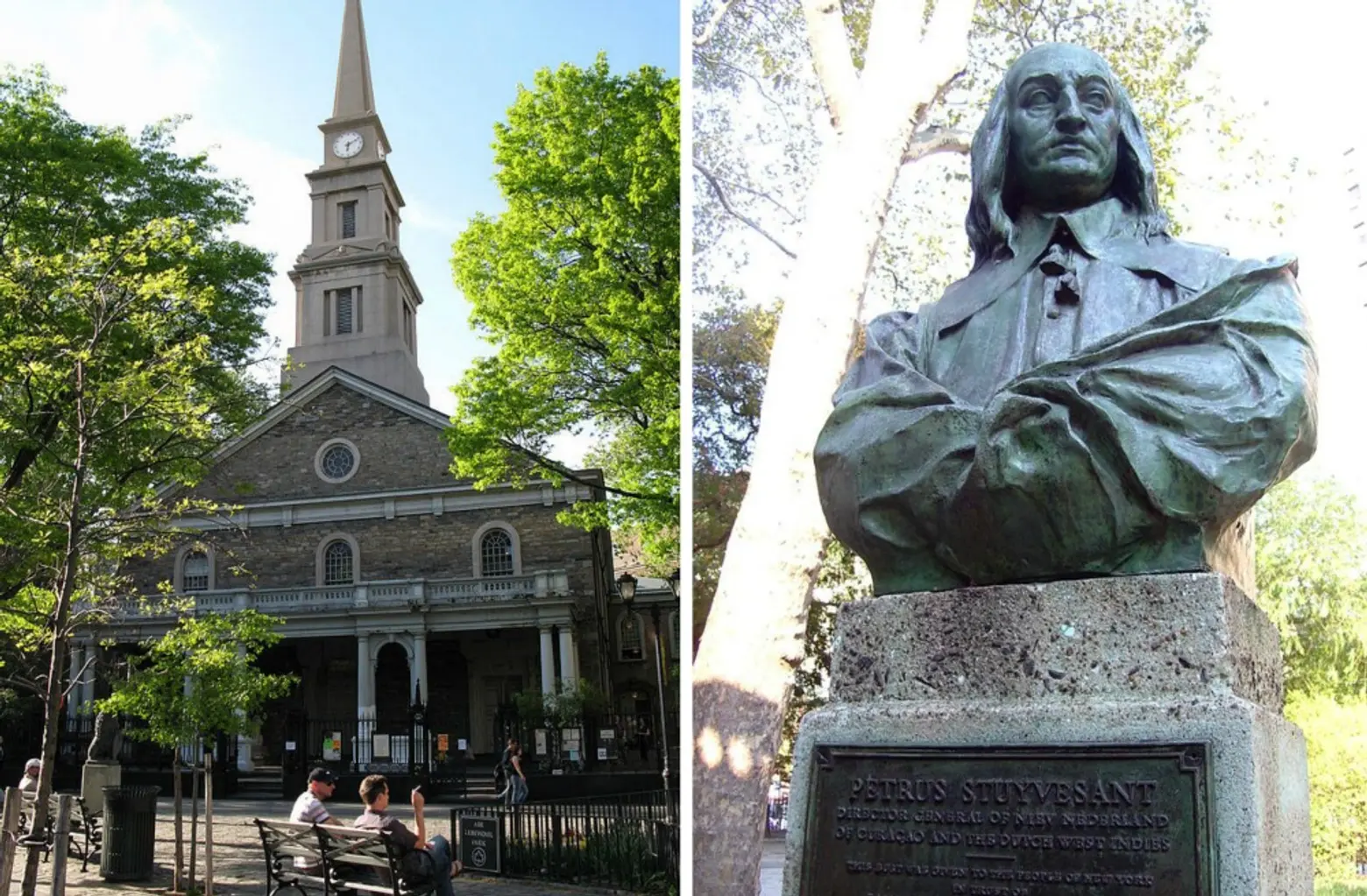 St. Mark’s Church in the Bowery (L); Bust of Peter Stuyvesant (R)
St. Mark’s Church in the Bowery (L); Bust of Peter Stuyvesant (R)
St. Mark’s Church in the Bowery sits on the oldest site of continuous worship in New York City and is the city’s second-oldest public building. The site, located on East 10th Street at the intersection of Second Avenue and Stuyvesant Street, was purchased by Peter Stuyvesant in 1651 as part of his Bouwerie, and he built his personal Dutch Reform Chapel on the site of the present-day church. When he died in 1672 he was buried in a vault beneath the church, where he remains today. In 1793, his great grandson, Peter Stuyvesant II, successfully lobbied Trinity Church to rebuild the family chapel on the same site. St. Mark’s Church in the Bowery was the first Episcopal Parish independent of Trinity Church in New York. It was built in fieldstone by the architect and mason John McComb, Jr. in the late Georgian style and completed in May of 1799. In 1915, a bust sculpture of Stuyvesant by Dutch artist Toon Dupuis was presented by the Dutch government to St. Mark’s Church.
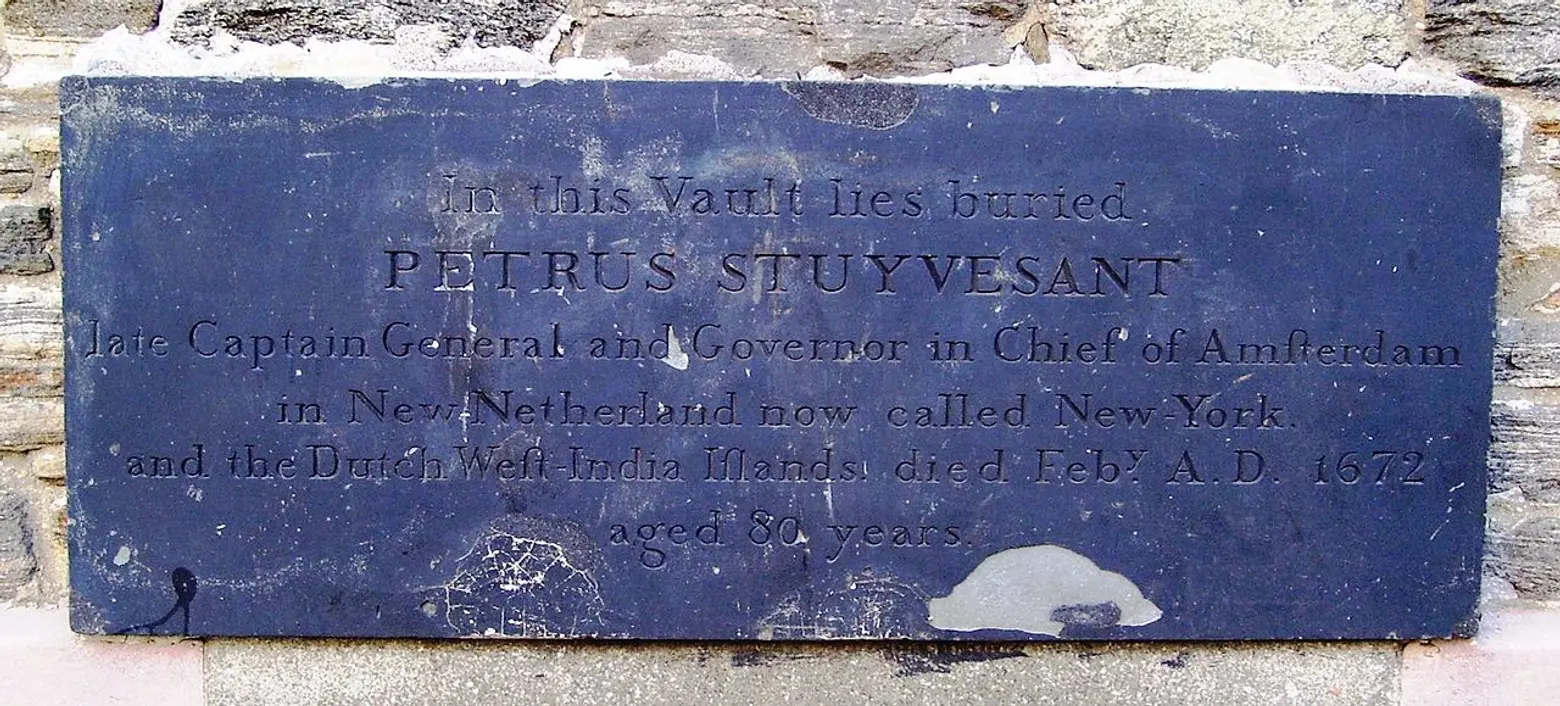 Peter Stuyvesant’s vault via Wiki Commons
Peter Stuyvesant’s vault via Wiki Commons
Along with Stuyvesant, other prominent families of the early 19th century are buried at St. Mark’s, including members of the Beekman, Fish, and Tompkins families. All of their vault markers are clearly visible in the grounds surrounding the church.
A Lasting Legacy
If you live in NYC, even if you know nothing about Peter Stuyvesant, you’re likely still familiar with the Stuyvesant name since so many locations and institutions bear it. Stuyvesant Town was named to commemorate its location on Stuyvesant’s former farm, and Bedford–Stuyvesant in Brooklyn also honors him. Peter Stuyvesant was an advocate for education, and therefore Stuyvesant High School took his name as well.
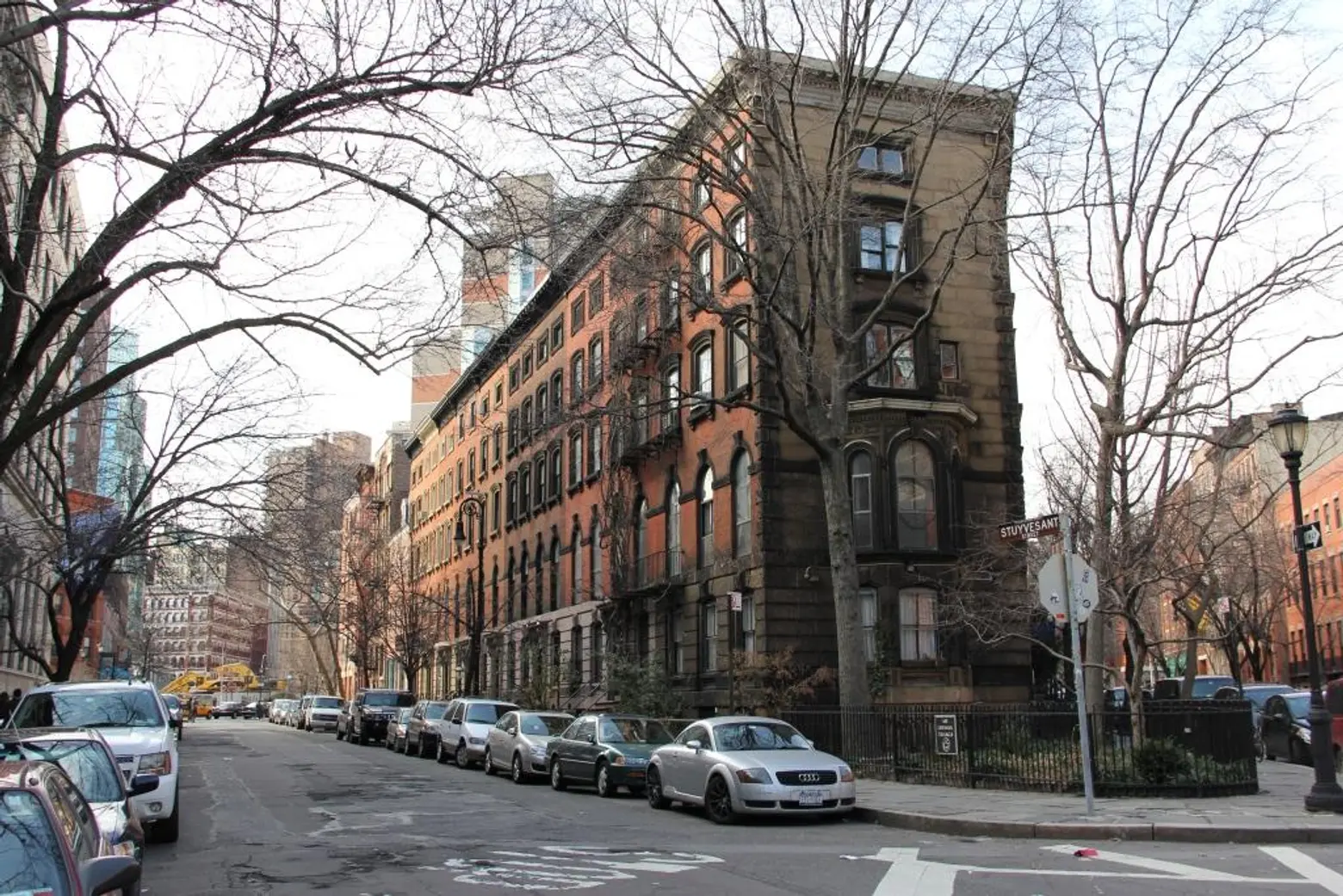 Stuyvesant Street via GVSHP
Stuyvesant Street via GVSHP
Stuyvesant Street in the East Village is now one of the shortest streets in the city, cutting diagonally from Second Avenue to Third Avenue, but was originally much longer, stretching from Fourth Avenue northeast to the Stuyvesant House on First Avenue. It served as a major thoroughfare at the time. The street is not named after Peter, but rather his great-grandson Petrus.
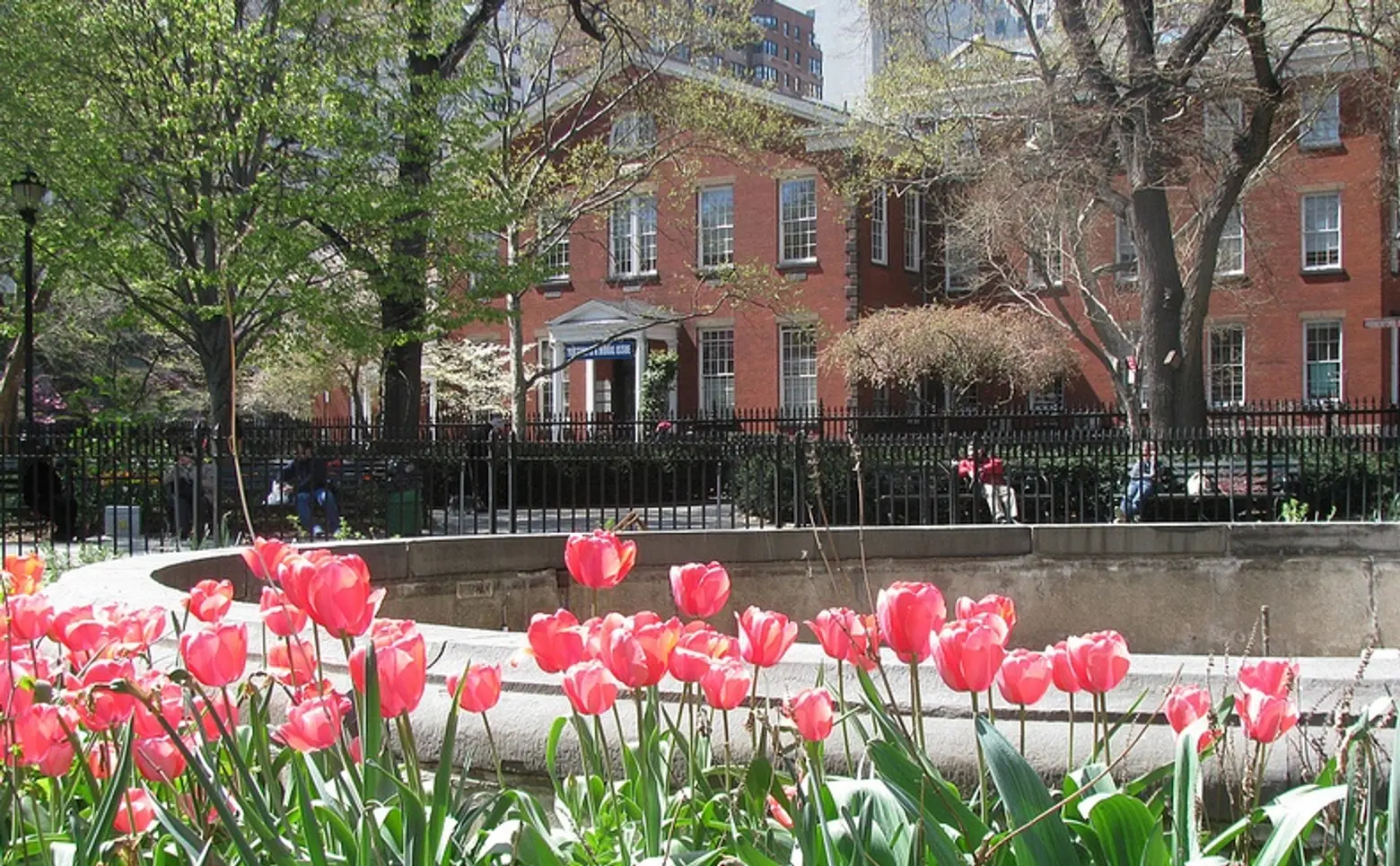
Stuyvesant Square via edenpictures via photopin cc
Another place named for one of Peter Stuyvesant’s descendants is Stuyvesant Square, the two-block park to the west of Stuyvesant Town. In 1836, his great-great-grandson Peter Gerard Stuyvesant, along with his wife Hellen Rutherford, sold four acres of the Stuyvesant farm to the city for $5 to be used as a public park. Eleven years later, the city erected the cast-iron fence around the park, which still stands as the second oldest in New York. In 1850 the landscaping was completed with two foundations, and the park was officially opened to the public. There is a full-body monument of Director General Peter Stuyvesant in the park.
Where to Celebrate NYC’s Dutch Heritage
Before coming to New Amsterdam, Peter Stuyvesant was the director of the Dutch West India Company’s colony in Curaçao. During an attack on the island of Saint Martin, he lost his right leg, leaving him “peg-legged.” Each year, the Neighborhood Preservation Center–a project of the St. Mark’s Historic Landmark Fund located in the Ernest Flagg rectory of St. Mark’s Church in the Bowery–hosts the Peg-Leg Pete Scavenger Hunt. The free competition tests participants’ knowledge of history and the buildings within the footprint of what was once Peter Stuyvesant’s farm. It’s taking place this Saturday at 11am as part of 5 Dutch Days.
Another event in 5 Dutch Days is the Wall Street Walking Tour, which leads guests through the southern tip of Manhattan, where the original Dutch trading post was located. These tours are ongoing and offered every day.
Know of any other fun Stuyvesant-related tidbits? Let us know in the comments.
Interested in similar content?
Leave a reply
Your email address will not be published.
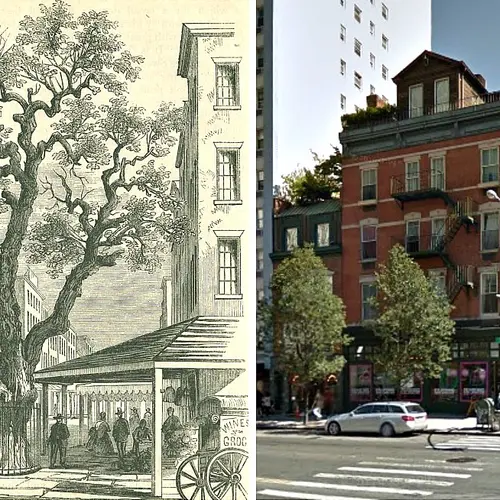
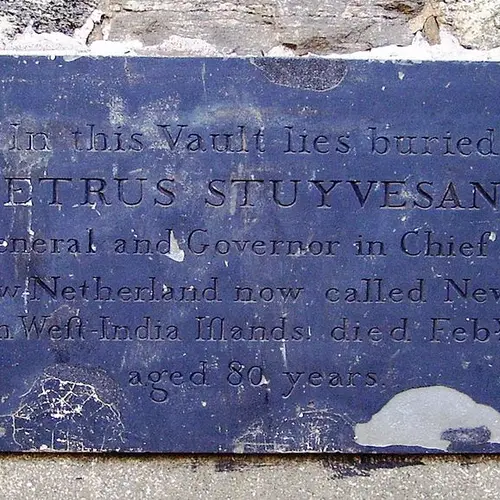
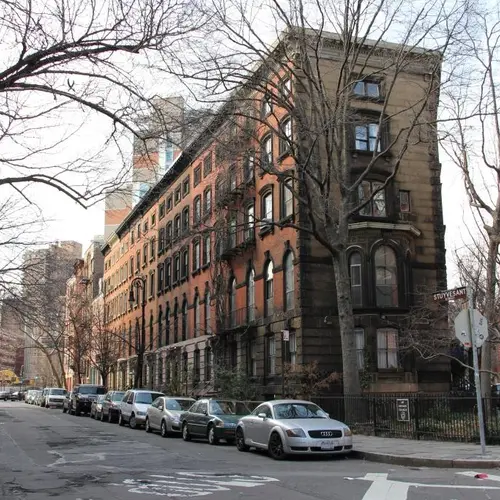
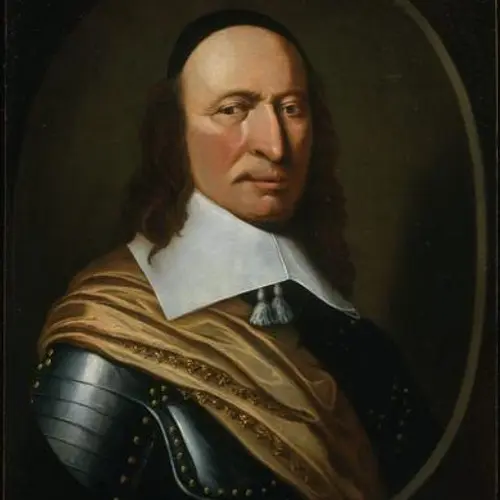
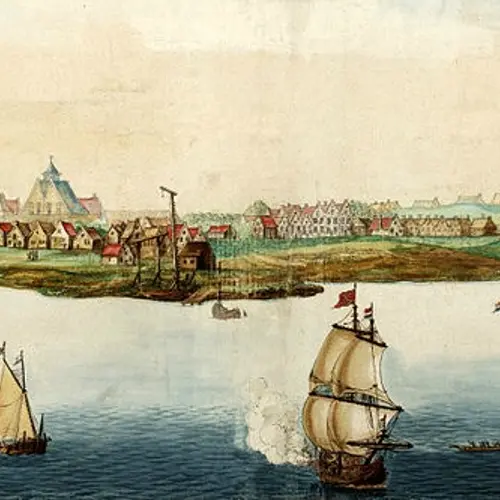
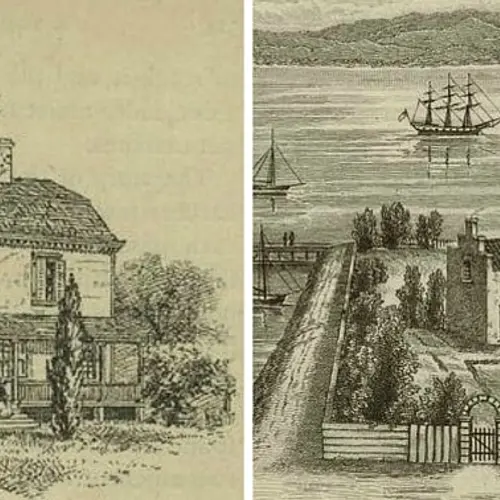
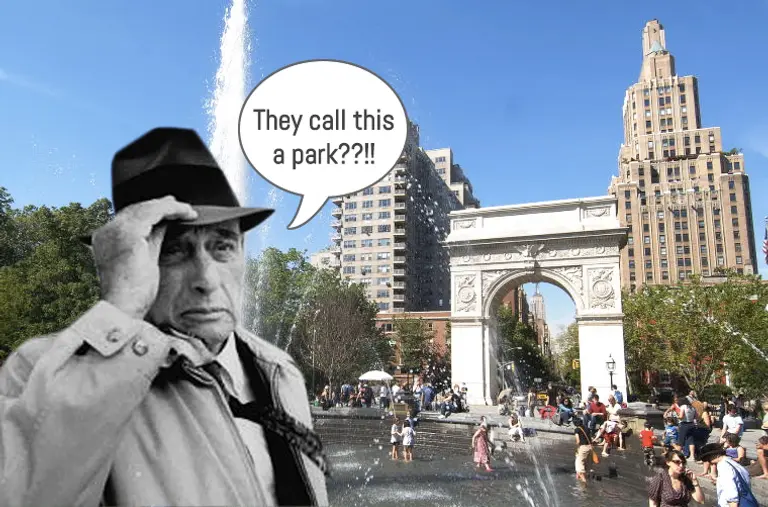
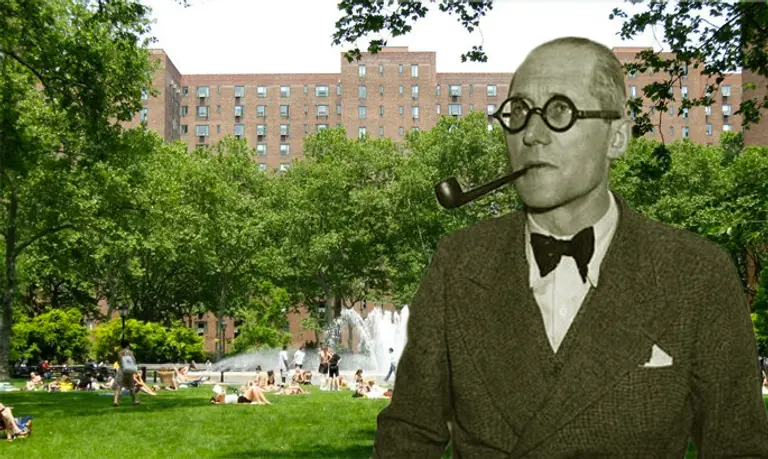
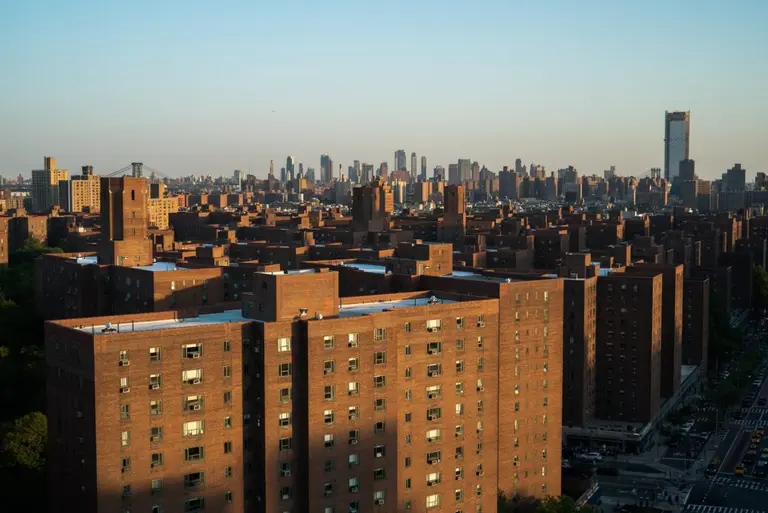
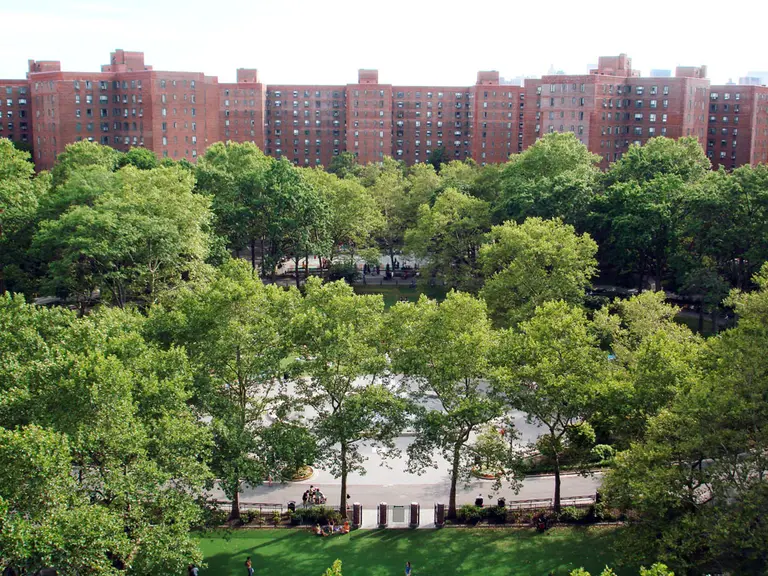
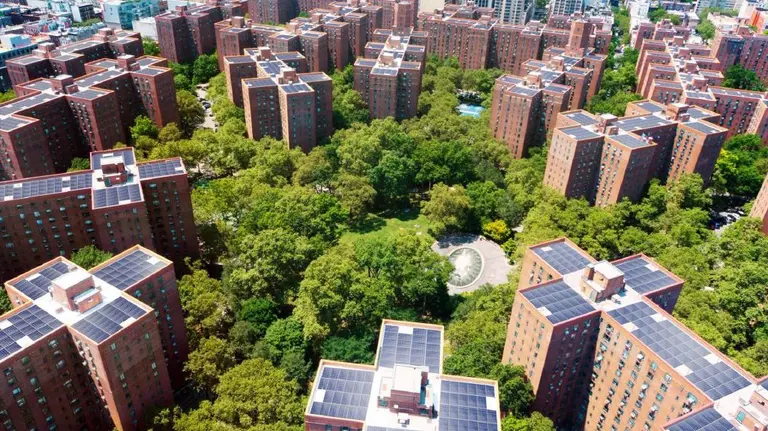






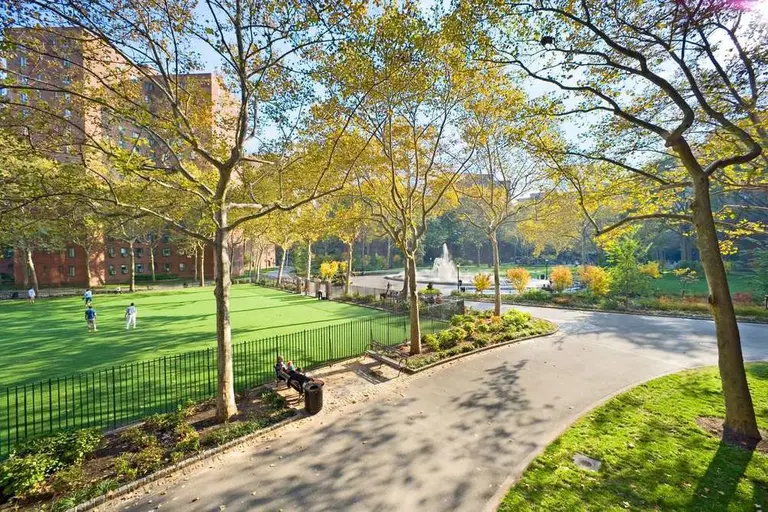
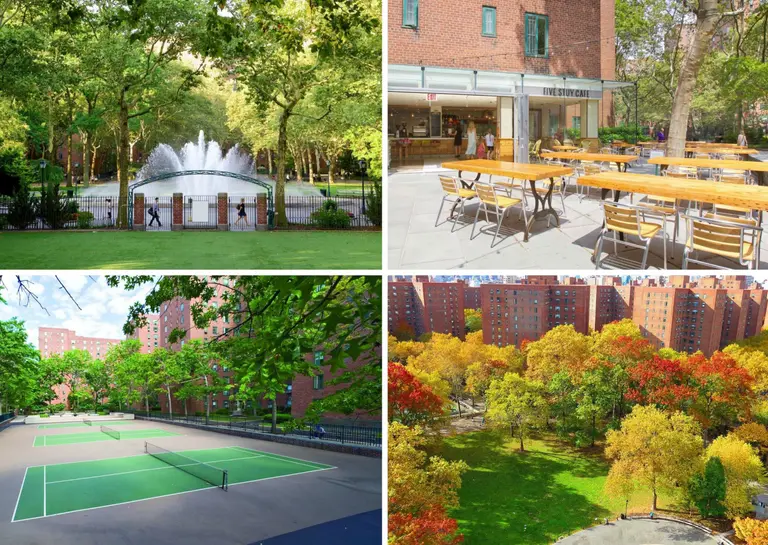

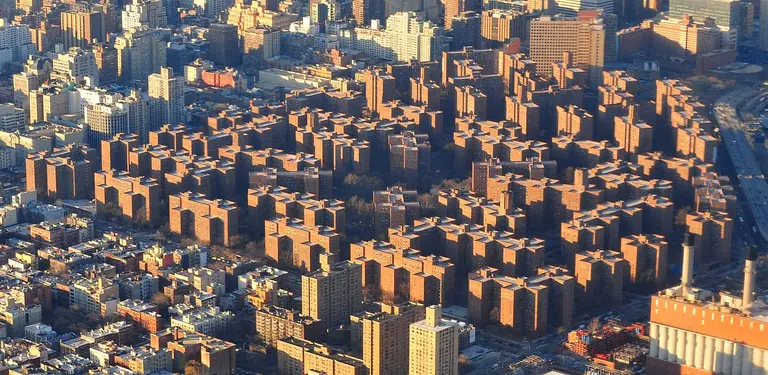












There is a sapling from that original Pear tree planted in the town park in my hometown that flourished and is still alive today and bearing fruit. So it still lives!
well done history. thanks